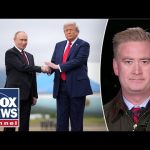In the bustling corridors of power, a dramatic meeting unfolded, bringing a wave of optimism to the forefront of U.S. diplomacy. As pundits and politicians shuffle through policies like a deck of cards, there’s one fact that’s grabbing headlines: former President Donald Trump stands once again in the spotlight, contemplating wrangling a global peace deal between Ukraine and Russia. At Joint Base in Anchorage, Alaska, the anticipation is palpable as the news delves into the intricacies of this potential diplomatic coup.
Vladimir Putin opened his mouth—rare for him, it seemed—to profess that the ongoing conflict in Ukraine might have never seen its first bullet had Trump remained in office. A bold declaration indeed, as if the Kremlin’s chief has suddenly taken up narrating historical what-ifs. Amidst this spectacle, Trump towers as a ten on the scale of influence, with the potential to tip the scales of peace in the region. The sentiment is clear: his looming presence might just be the chess piece needed to coax a truce out of these two sparring nations—a thought-provoking notion, to say the least.
As fingers point, none seem to find a firmer target than Vladimir Putin as the chief architect of the ongoing war. Though rhetoric spills faster than reason, Lindsey Graham showed a glimmer of hope, asserting the historic meeting might pave a path to peace before the festive cheer of Christmas. If that sounds ambitious, it’s because it undoubtedly is. The spotlight falls on Trump, who might just turn this political theater into an act of reconciliation. The prospect of Zelenskyy and Putin finally meeting, with Trump looming as the mediator, is indeed a tantalizing twist in this complex saga.
But before trumpets of celebration can sound, there’s the ever-looming threat of “severe consequences” if the moment of negotiation falls apart. Senator Tom Cotton, joining the dialogue, reassures that expectations were measured—a breath of fresh air in a world accustomed to lofty promises and fragile outcomes. While no immediate armistice sprang from this meeting in Anchorage, the stage is dramatically set for the next chapter, where the formidable trio of leaders might finally dislodge the stalemate and kindle a burst of peace talks.
As the political stage widens, it becomes clear that the diplomatic strategy could involve a classic case of land swaps and security guarantees. Yet, the United States intends to let Ukraine lead the charge, crafting a peace settlement that reflects its own vision. Skeptics may smirk at this long-shot diplomacy, yet for now, Trump’s reemergence as a peacebroker stirs hope—and perhaps a little envy—from those accustomed to seeing the current administration struggle to gauge its diplomatic landscape. Weary of the past hesitations that defined American foreign policy, there’s an air of anticipation that the tables could be turning. After all, when the stakes are this high, it’s not just about who’s sitting at the table but the hands dealing the cards.




